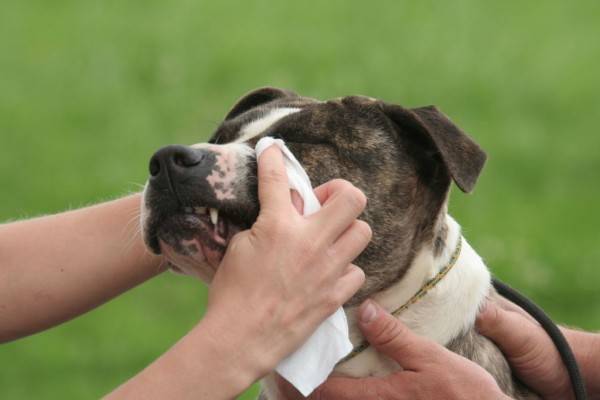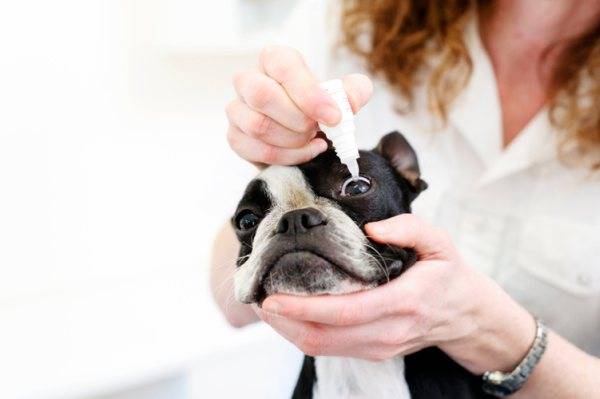Dog conjunctivitis is an inflammatory disease visual apparatus affecting the mucous membrane lining the inner surface of the eyelid and the eyeball. In most cases this disease occurs due to a weakened immune system or chronic diseases of a pet. There are two forms conjunctivitis in pets – acute and chronic. Such a disease requires competent and timely treatment, as it is fraught serious complications, up to a complete violation in the animal visual function.
Content
- 1. Causes of conjunctivitis in dogs
- 2. Symptoms of dogs conjunctivitis
- 3. Types of canine conjunctivitis
- 4. Treatment of conjunctivitis in dogs
- 5. How to understand what you need to go to the ophthalmologist
- 6. How to prevent the occurrence of ocular pathology
Causes of conjunctivitis in dogs
Contents

Catarrhal conjunctivitis in a dog photo
Conjunctivitis in dogs develops due to exposure pathogens from the air to conjunctiva lining the surface of the eyeball, and penetrating into the so-called conjunctival sac. At weakening of the animal’s immunity begins to develop inflammatory process that develops into conjunctivitis.
In addition, veterinary specialists note other causes contributing to the onset and development of conjunctivitis in dogs:
- Traumatic eye damage.
- Contacting the mucous membrane of the eye with chemicals.
- Inflammatory processes localized in the eyelids and ocular cornea.
- Contact on the conjunctiva of dust, wool, fluff and other small foreign particles and bodies.
- Infectious diseases of an endogenous nature.
- Frostbite.
- Burning eye lesions.
- Deficiency of vitamins of group A in the body of a pet.
- Increased tendency to allergic reactions.
- The presence of fungal or viral infections.
- Eye diseases affecting the lacrimal glands.
- Disruption of metabolic processes.
- Eyelash ingrowth.
In addition, it is believed that the most prone to conjunctivitis dogs of the Doberman breed and Great Dane, therefore their owners need to be especially attentive to the health status of the eyes of their pets. IN high-risk group also includes pugs, Pekingese Yorkshire terriers and bulldogs.
Symptoms of Dog Conjunctivitis
Dog conjunctivitis, regardless of the type and form of the course disease, manifests itself in the following characteristic symptoms:
- Redness of the mucous membrane of the ocular membrane.
- Increased lacrimation.
- Baldness of the eyelids.
- Swelling of the eyelids and mucous membranes of the eyes.
- The appearance of specific secretions that are purulent or purulent-mucous character.
You can also suspect a disease by paying attention to pet behavior. Since conjunctivitis is accompanied by discomfort and severe pain, localized in the field of vision, the dog becomes nervous, irritable, passive, often squinting and rubs his eyes with paws. Often with conjunctivitis in an animal sleep disturbances and a permanent lack of appetite are observed.
Types of canine conjunctivitis

Conjunctivitis in dogs is divided into 4 types, each of which need different care
According to the international classification, conjunctivitis in dogs divided into 4 species, each of which is characterized by specific signs, pathogenesis and manifestations:
- Catarrhal conjunctivitis, in most cases, occurs with traumatic lesions of the ocular membrane, and also against a background of infectious diseases. This form the disease manifests itself as redness and increased swelling conjunctiva (up to its full protrusion from under the eyelid), hyperemia, profuse ocular discharge, wearing serous or same purulent-mucous character.
- Purulent form of conjunctivitis – develops with contact with the mucous membrane of the ocular membrane of bacteria and pathogens pyogenic microorganisms. Usually purulent conjunctivitis the disease in dogs affects both eyes at the same time and proceeds exclusively in acute form, characterized by rapid development. A purulent type of pathology manifests itself with such signs as swelling of the eyelids, fever, photophobia, and also blepharospasm. Dense conjunctivitis is characterized by thick eye discharge, grayish yellow with a very unpleasant smell, which, drying up, form in the eyelids, eyelashes and corners eye specific crusts. In severe cases, it may there is clouding of the ocular cornea. This form of conjunctivitis requires prompt, timely treatment, as it is fraught complete loss of sight to animals.
- Allergic conjunctivitis – observed in dogs with a high tendency to allergic reactions. The inflammatory process begins when it gets on conjunctiva or mucous membrane of any allergen. Wherein specific symptoms are observed in the form of profuse lacrimation, redness of the eyelids and the eye itself.
- Follicular conjunctivitis – occurs with exposure to the ocular membrane of dust, smoke or foreign particles bodies affecting the lymphatic follicles of the eyelids or as complications of the catarrhal form of conjunctival disease. Characteristic symptoms of follicular conjunctivitis is severe redness of the eye membranes, intense purulent discharge, and also abundant accumulation of lymphatic follicles in the area the inner surface of the eyelids.
Dog conjunctivitis treatment

Eye drops can be used to treat conjunctivitis. bactericidal action
A complete treatment for conjunctivitis in dogs should be prescribed individually, by a qualified specialist – veterinarian, in depending on the type and form of the course of the disease, as well as the presence associated complications.
It is possible to alleviate the condition of the pet at home, several once a day washing eyes with a cotton swab dipped in tea broth, calendula or chamomile pharmacy. Compresses and washing eyes with decoctions of herbs antibacterial and anti-irritant effects.
You can also use solutions to wash your eyes. furatsilina, potassium permanganate or boric acid. Reduce pain sensations and inflammation can also be instilled in the eyes of a home darling a couple drops of almond oil or drops like conjunctVET, Maxidin, Iris.
At the time of the therapeutic course, it is recommended that reduce walking time with animals to avoid contact with dust, pollen, smoke, pathogens and prevent possible hypothermia, which is extremely undesirable with conjunctivitis.
Veterinarians use these to treat conjunctivitis in dogs. medications like ointments that relieve inflammation, antibiotics, bactericidal eye drops and drugs internal use with anti-inflammatory and analgesic properties. The animal may also be shown special vitamin complexes aimed at strengthening the immune system and increase your own defenses organism.
With an allergic form of the disease are prescribed anti-allergic drugs and drops, antihistamines medicines.
In most cases, after washing the eyes, drops are instilled, and then after 10-15 minutes to the surface of the eyelids and inner corners Penicillin or tetracycline ointment is applied to the eye.
Such therapeutic procedures are carried out 3-4 times per day, for 1-2 weeks, it depends, first of all, on pet status.
However, prescribe specific drugs, determine their dosage and The duration of treatment should only be a veterinarian! Do this alone is not recommended in any case, because, that way you can cause irreparable damage to the animal’s health harm!
In order to avoid possible relapses and unwanted complications, it is very important to strictly adhere to all recommendations veterinarian and do not stop treatment ahead of time, even if if the animal has disappeared all the painful symptoms! Like this way need to treat conjunctivitis in dogs.
How to understand what you need to go to an ophthalmologist
How to prevent the occurrence of ocular pathology
Prevention of conjunctivitis in dogs is, first the turn in compliance with sanitary standards and proper pet care. Dog’s sleeper must be dry and clean, changing litter is recommended every week.
Regularly, and preferably every 2 days, it is recommended to rinse the eyes of the animal with cotton swabs dipped in a decoction of chamomile or tea leaves.
In addition, you need to pay attention to your diet pet, making sure that the food was as much as possible balanced and it certainly included foods rich in vitamins A and E.
Without fail, it will be necessary to exclude or at least restrict pet contact with people or others animals suffering from conjunctivitis. When walking, do not allow the pet to play in dust, dirt or sand to exclude hit of their particles on the mucous membrane of the eye.
Conjunctivitis in dogs is a rather serious and dangerous disease, affecting the organs of vision of a pet. However, proper care, timely initiation of treatment and compliance with recommendations a veterinarian will help to quickly defeat this ailment, avoiding possible complications and unpleasant consequences!






